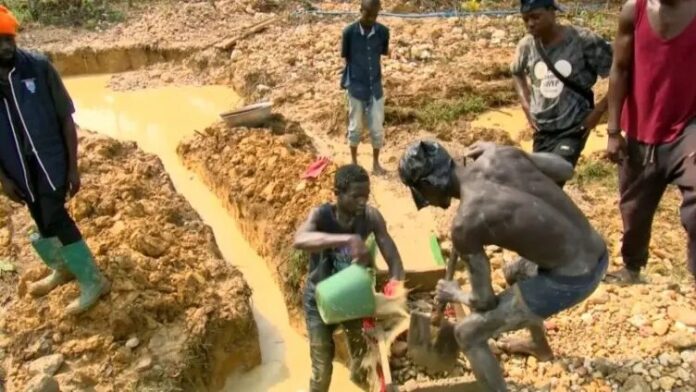I had initially decided not to write about why illegal small-scale mining, or galamsey, cannot be solved under Ghana’s current political culture.
The reason is simple: this is ultimately a matter of policy, not politics.
And too often, the Ghanaian public shies away from discussions of policy. A friend challenged me: It is the task of the writer to woo readers. So, let us attempt brevity, aided by data and simple illustrations.
Politics versus Policy
In every democracy, politicians focus on what people want so that they can remain in power. The mechanisms that deliver those demands are policy.
In Ghana, citizens want two things at the same time:
- An end to the pollution caused by galamsey.
- A stable cedi, which relies heavily on strong gold revenues.
To balance these demands, politicians have settled on converting illegal galamsey into legal “community mining” projects. The logic is that this will sustain gold production while reducing environmental damage.
It was such a programme that a government delegation was on its way to launch in Obuasi when the tragic helicopter crash occurred.
The difficulty is that the politics, “end galamsey now” and “protect the cedi”, receive most of the attention. The underlying policy legalising small-scale mining as a strategy to combat galamsey rarely receives critical scrutiny. This creates a messy gap between politics and policy. I call this gap katanomics.
The Numbers Behind Galamsey
The reality of galamsey becomes clearer when examined through data.
- In 2023, there were around 34,000 workers in large-scale mining (LSM) in Ghana, compared to an estimated 1.1 million workers in small-scale mining (ASM).
- Productivity differs sharply. The average LSM worker produces about 2,625 grams of gold annually. In ASM, the figure is at most 31 grams per worker. Even if one accounts for smuggling and raises the estimate to 100 grams, the gap is staggering.
- Translated into value-add, this means an ASM worker generates about $2,000 a year. Even if doubled to account for hidden factors, it pales in comparison to the $163,000 generated annually by each LSM worker.
The disparity is, quite simply, extraordinary.
Land Use and Density
The efficiency gap is even more evident when comparing land use:
- Large-scale miners extract about 86 kilograms of gold per square kilometre.
- Small-scale miners extract between 44 and 73 kilograms per square kilometre.
Moreover, LSM operations are spread across large concessions, typically around 70 square kilometres, with an average of 30 workers per square kilometre.
By contrast, ASM and galamsey operations crowd around 1,500 workers into each square kilometre.
To scale community mining up to match one LSM project would mean accommodating approximately 105,000 workers in a single operation. Clearly, this is unfeasible.
Why Community Mining Struggles
If galamsey mirrors ASM productivity, then its legalisation under the banner of community mining cannot, by itself, deliver environmental sustainability.
Large-scale miners can afford to invest in filtration systems, tailings dams, and treatment plants because of the high value generated per worker. ASM and galamsey operators, by contrast, lack such resources.
For community mining to become viable, it would require:
- Drastically reducing employment in the sector.
- Massive retraining of workers.
- Hiring of skilled engineers and machine operators.
- Allocation of large tracts of high-quality deposits.
This is extremely difficult to achieve without strict, consistent oversight and a political class willing to resist short-term expediency.
The Accountability Gap
And here lies the central issue: success would require tight scrutiny by a well-informed and vocal citizenry, unafraid to publicise results and hold leaders accountable. In the absence of this, political convenience will continue to dominate.
That is, unfortunately, where Ghana finds itself today.
Conclusion
The uncomfortable truth is that galamsey cannot be solved by political slogans or symbolic legislation. The underlying economics, low productivity, high labour density, and unsustainable land use make success nearly impossible under current conditions.
Unless the political culture changes to allow serious, sustained policy oversight, Ghana’s fight against galamsey will remain trapped in katanomics: policies that sound plausible in political terms but collapse in practice.
In a forthcoming piece, I intend to expand these arguments into a more rigorous study. For now, those interested in further details may consult:
- Why Ghana’s Galamsey Fight Has Become a Waste of Time
- Constitutional Change as Normative Crystallisation
For those more interested in the actual research from a professional or academic standpoint, a high-level overview of the evolving methodology is attached below:



ALSO READ:
- Galamsey Fight: Lands Ministry hints at possible repeal of LI 2462 in renewed measures
-
Galamsey fight: We’ll withdraw our cooperation if… – Miracles Aboagye to NDC gov’t
Source: Bright Simons
*********
The writer, Bright Simons, is the honorary Vice President of IMANI Africa


